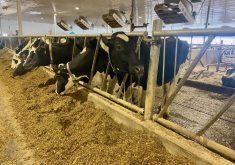WINNIPEG – Although Australia has fewer farms than Canada – 143,000 to 170,000 – it appears that farms in the Land Down Under are more dangerous than farms in Canada.
Each year, about 150 farmers or farm family members are killed on Australian farms, said Australian safety expert Eric Young. By comparison, about 118 deaths occur on Canadian farms each year.
Australia also hospitalizes about 6,500 people a year as a result of farm injuries compared to the 1,727 people hospitalized in Canada.
Speaking last fall to the conference of the Canadian Agricultural Safety Association, Young said the Australian state of Victoria wanted to lower those accident rates.
Read Also

Powerful solar storm lights up night time sky
Prairie skywatchers have been on high alert the last few nights as spectacular aurora displays have made the night time…
In Victoria, tractor-related deaths were causing two-thirds of the farm fatalities. Since 1985, tractor accidents have killed 114 people in the state.
After a 10-year campaign to add rollover protective structures, or ROPS, to all tractors, Victoria had three tractor-related deaths in 2001 and one in 2002.
The deaths in 2001 involved older farmers who did not have ROPS on their tractors.
Young said the main cause of farm fatalities in Victoria today is all-terrain vehicle accidents, electrical contacts and falls from heights.
According to Young, Victoria’s successful ROPS campaign had the potential to cause a lot of controversy among Australian farmers, who Young called “independent rascals.”
Because financial incentives to upgrade equipment were rare, program organizers feared it would be difficult to persuade farmers that “safety is a benefit, not a cost.”
The state, which is home to one-quarter of Australia’s farms, began an information campaign in 1990 and offered a subsidy so farmers could afford to fit ROPS on their tractors.
Accident figures were improving but safety experts felt the number of fatalities was not falling quickly enough. In 1996, the state came out with a regulation: All tractors built in Victoria or imported would require a ROPS frame.
Victoria officials gave themselves four years to ensure every working tractor had the frame refit. Farmers were offered $150 Aus each to have their tractors outfitted.
State officials and farm safety experts then met with the farmers federation, which fast-tracked the program and set a new target date of 1998.
Young said it was a powerful message of support to hear farmers say they wanted the problem cleared up sooner.
The Victoria campaign led to 12,189 tractors getting ROPS, but state officials estimated there were 6,000 more that hadn’t been fitted. The government issued notices to those who hadn’t complied and another 4,000 ROPS were installed.
State officials estimate that by 2002, 96 percent of Victoria’s working tractors had ROPs.
The result was that farm fatalities caused by tractor rollovers in Victoria dropped from 43 percent of all farm deaths to nine percent.
Young said the government learned that educating farmers, regulating the industry through legislation and securing farmer and manufacturer support can be successful.
“The expectation now is that if you have a tractor and it doesn’t have ROPs, you are not only breaking the law but being irresponsible,” Young said.
Tractors were also the focus of another project in the state.
A farmers’ organization and the Monash University at Melbourne received $100,000 in federal and state funds to develop a rating system to compare safety features on the machinery.
Research scientist Lesley Day told a farm safety conference in Saskatoon about the system that was released last fall. It compares various tractor models for ROPS, guards, locks, hitches and other built-in features. To see the system, go to www.producer.com and click on Links in the News.
The system is a voluntary audit that can be done in 45 minutes by anyone familiar with tractor basics.














